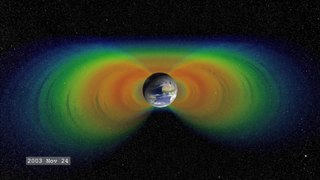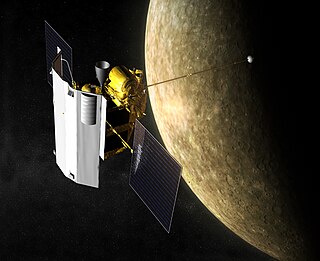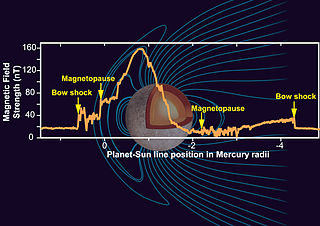
In astronomy and planetary science, a magnetosphere is a region of space surrounding an astronomical object in which charged particles are affected by that object's magnetic field. It is created by a celestial body with an active interior dynamo.

The solar wind is a stream of charged particles released from the upper atmosphere of the Sun, called the corona. This plasma mostly consists of electrons, protons and alpha particles with kinetic energy between 0.5 and 10 keV. The composition of the solar wind plasma also includes a mixture of materials found in the solar plasma: trace amounts of heavy ions and atomic nuclei of elements such as C, N, O, Ne, Mg, Si, S, and Fe. There are also rarer traces of some other nuclei and isotopes such as P, Ti, Cr, and 58Ni, 60Ni, and 62Ni. Superimposed with the solar-wind plasma is the interplanetary magnetic field. The solar wind varies in density, temperature and speed over time and over solar latitude and longitude. Its particles can escape the Sun's gravity because of their high energy resulting from the high temperature of the corona, which in turn is a result of the coronal magnetic field. The boundary separating the corona from the solar wind is called the Alfvén surface.

Van Allen radiation belt is a zone of energetic charged particles, most of which originate from the solar wind, that are captured by and held around a planet by that planet's magnetosphere. Earth has two such belts, and sometimes others may be temporarily created. The belts are named after James Van Allen, who is often credited with their discovery.

A coronal mass ejection (CME) is a significant ejection of magnetic field and accompanying plasma mass from the Sun's corona into the heliosphere. CMEs are often associated with solar flares and other forms of solar activity, but a broadly accepted theoretical understanding of these relationships has not been established.

MESSENGER was a NASA robotic space probe that orbited the planet Mercury between 2011 and 2015, studying Mercury's chemical composition, geology, and magnetic field. The name is a backronym for "Mercury Surface, Space Environment, Geochemistry, and Ranging", and a reference to the messenger god Mercury from Roman mythology.

Magnetic reconnection is a physical process occurring in electrically conducting plasmas, in which the magnetic topology is rearranged and magnetic energy is converted to kinetic energy, thermal energy, and particle acceleration. Magnetic reconnection involves plasma flows at a substantial fraction of the Alfvén wave speed, which is the fundamental speed for mechanical information flow in a magnetized plasma.

The magnetosphere of Saturn is the cavity created in the flow of the solar wind by the planet's internally generated magnetic field. Discovered in 1979 by the Pioneer 11 spacecraft, Saturn's magnetosphere is the second largest of any planet in the Solar System after Jupiter. The magnetopause, the boundary between Saturn's magnetosphere and the solar wind, is located at a distance of about 20 Saturn radii from the planet's center, while its magnetotail stretches hundreds of Saturn radii behind it.

Cluster II is a space mission of the European Space Agency, with NASA participation, to study the Earth's magnetosphere over the course of nearly two solar cycles. The mission is composed of four identical spacecraft flying in a tetrahedral formation. As a replacement for the original Cluster spacecraft which were lost in a launch failure in 1996, the four Cluster II spacecraft were successfully launched in pairs in July and August 2000 onboard two Soyuz-Fregat rockets from Baikonur, Kazakhstan. In February 2011, Cluster II celebrated 10 years of successful scientific operations in space. In February 2021, Cluster II celebrated 20 years of successful scientific operations in space. As of March 2023, its mission has been extended until September 2024. The China National Space Administration/ESA Double Star mission operated alongside Cluster II from 2004 to 2007.

The Global Geospace Science (GGS) Wind satellite is a NASA science spacecraft designed to study radio waves and plasma that occur in the solar wind and in the Earth's magnetosphere. It was launched on 1 November 1994, at 09:31:00 UTC, from launch pad LC-17B at Cape Canaveral Air Force Station (CCAFS) in Merritt Island, Florida, aboard a McDonnell Douglas Delta II 7925-10 rocket. Wind was designed and manufactured by Martin Marietta Astro Space Division in East Windsor Township, New Jersey. The satellite is a spin-stabilized cylindrical satellite with a diameter of 2.4 m and a height of 1.8 m.

The plasmasphere, or inner magnetosphere, is a region of the Earth's magnetosphere consisting of low-energy (cool) plasma. It is located above the ionosphere. The outer boundary of the plasmasphere is known as the plasmapause, which is defined by an order of magnitude drop in plasma density. In 1963 American scientist Don Carpenter and Soviet astronomer Konstantin Gringauz proved the plasmasphere and plasmapause's existence from the analysis of very low frequency (VLF) whistler wave data. Traditionally, the plasmasphere has been regarded as a well behaved cold plasma with particle motion dominated entirely by the geomagnetic field and, hence, co-rotating with the Earth.

Time History of Events and Macroscale Interactions during Substorms (THEMIS) mission began in February 2007 as a constellation of five NASA satellites to study energy releases from Earth's magnetosphere known as substorms, magnetic phenomena that intensify auroras near Earth's poles. The name of the mission is an acronym alluding to the Titan Themis.

Geotail was a satellite that observed the Earth's magnetosphere. It was developed by Japan's ISAS in association with the United States' NASA, and was launched by a Delta II rocket on 24 July 1992 from Cape Canaveral Air Force Station.

The magnetosphere of Jupiter is the cavity created in the solar wind by Jupiter's magnetic field. Extending up to seven million kilometers in the Sun's direction and almost to the orbit of Saturn in the opposite direction, Jupiter's magnetosphere is the largest and most powerful of any planetary magnetosphere in the Solar System, and by volume the largest known continuous structure in the Solar System after the heliosphere. Wider and flatter than the Earth's magnetosphere, Jupiter's is stronger by an order of magnitude, while its magnetic moment is roughly 18,000 times larger. The existence of Jupiter's magnetic field was first inferred from observations of radio emissions at the end of the 1950s and was directly observed by the Pioneer 10 spacecraft in 1973.

The Magnetospheric Multiscale (MMS) Mission is a NASA robotic space mission to study the Earth's magnetosphere, using four identical spacecraft flying in a tetrahedral formation. The spacecraft were launched on 13 March 2015 at 02:44 UTC. The mission is designed to gather information about the microphysics of magnetic reconnection, energetic particle acceleration, and turbulence — processes that occur in many astrophysical plasmas. As of March 2020, the MMS spacecraft have enough fuel to remain operational until 2040.

Mercury's magnetic field is approximately a magnetic dipole apparently global, on planet Mercury. Data from Mariner 10 led to its discovery in 1974; the spacecraft measured the field's strength as 1.1% that of Earth's magnetic field. The origin of the magnetic field can be explained by dynamo theory. The magnetic field is strong enough near the bow shock to slow the solar wind, which induces a magnetosphere.

The Heliophysics Science Division of the Goddard Space Flight Center (NASA) conducts research on the Sun, its extended Solar System environment, and interactions of Earth, other planets, small bodies, and interstellar gas with the heliosphere. Division research also encompasses geospace—Earth's uppermost atmosphere, the ionosphere, and the magnetosphere—and the changing environmental conditions throughout the coupled heliosphere.

Solar phenomena are natural phenomena which occur within the atmosphere of the Sun. They take many forms, including solar wind, radio wave flux, solar flares, coronal mass ejections, coronal heating and sunspots.

Magnetometer (MAG) is an instrument suite on the Juno orbiter for planet Jupiter. The MAG instrument includes both the Fluxgate Magnetometer (FGM) and Advanced Stellar Compass (ASC) instruments. There two sets of MAG instrument suites, and they are both positioned on the far end of three solar panel array booms. Each MAG instrument suite observes the same swath of Jupiter, and by having two sets of instruments, determining what signal is from the planet and what is from spacecraft is supported. Avoiding signals from the spacecraft is another reason MAG is placed at the end of the solar panel boom, about 10 m and 12 m away from the central body of the Juno spacecraft.

James Wynne Dungey (1923–2015) was a British space scientist who was pivotal in establishing the field of space weather and made significant contributions to the fundamental understanding of plasma physics.

Magnetic switchbacks are sudden reversals in the magnetic field of the solar wind. They can also be described as traveling disturbances in the solar wind that caused the magnetic field to bend back on itself. They were first observed by the NASA-ESA mission Ulysses, the first spacecraft to fly over the Sun's poles. NASA's Parker Solar Probe and NASA/ESA Solar Orbiter both observed switchbacks.




















